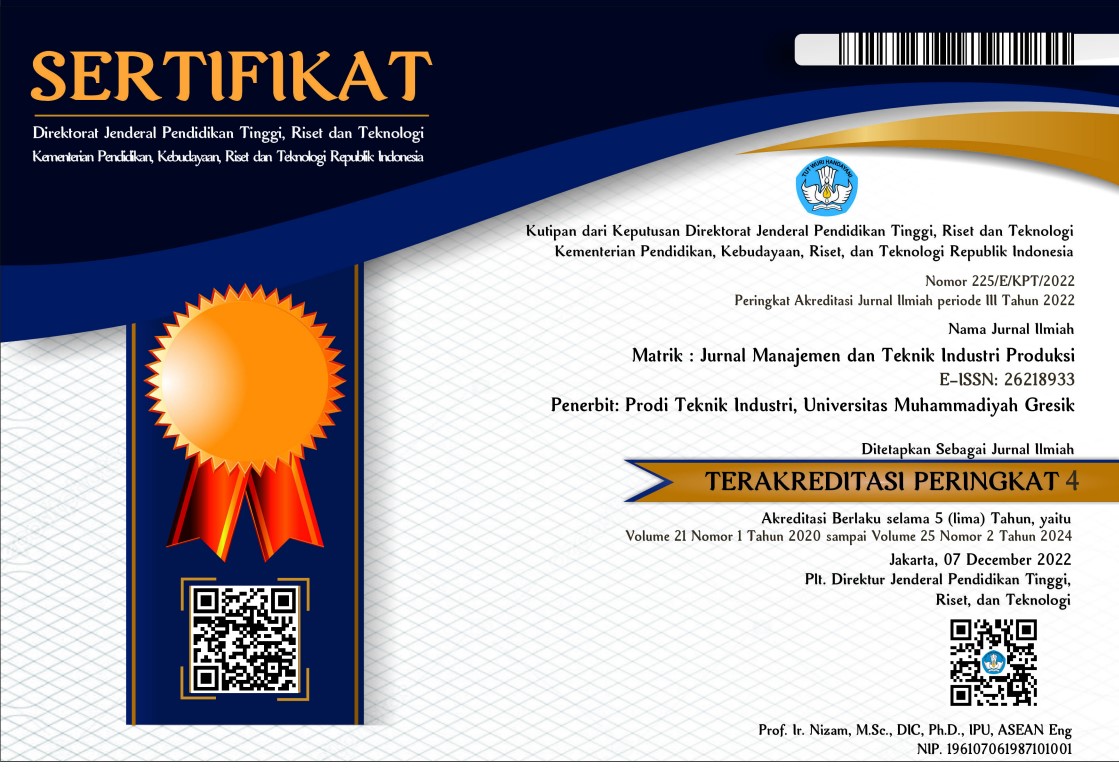PENGARUH FAKTOR FAKSI MASSA CAMPURAN KOMPOSIT ABU SEKAM PADI DAN TEMPERATUR PEMANASAN TERHADAP SIFAT MEKANIK (UJI TEKAN DAN UJI DAYA SERAP AIR)
DOI:
https://doi.org/10.30587/matrik.v25i1.7868Keywords:
Redesign, Rice Husk Ash, Concrete Bricks, Anova, Tukey TestAbstract
Kemajuan lifestyle manusia dapat menimbulkan tantangan baru. Bahan alternatif menjadi solusi dalam permasalahan tersebut, salah satunya dengan penerapan 6R (Reuse, Recycle, Redesign, Remanufacture, Reduce, Recovery). Campuran Komposit dikembangkan untuk bahan pengganti logam dikarenakan Campuran Komposit mempunyai sifat mekanis yang baik. Abu sekam padi, serpihan limbah kayu, dan bahan lainnya yang mempunyai serat merupakan bahan alami dapat digunakan dalam pembuatan campuran komposit. Data statistik Indonesia merekap yang dimana adanya hasil panen padi mencapai 79.141 juta ton gabah kering yang sudah tergiling. Tingginya panen padi tersebut juga akan menghasilkan limbah abu sekam padi yang melimpah sesuai dengan banyaknya panen padi. berpotensi digunakan sebagai jenis SCM (suplementary Cementitious Material) karena aktivitas pozzolan yang tinggi dan jumlah silika yang besar sebanyak 80 hingga 85% silika yang sangat reaktif. Hal tersebut menjadikan potensi besar limbah abu sekam padi di Indonesia untuk dijadikan bahan campuran pembuatan produk batako. Penelitian ini bertujuan mengkur batako dengan campuran sekam padi, variabel independentnya yaitu temperatur pemanasan yang digunakan benda uji yaitu 3 level (40℃, 50℃,60℃) dan Faksi Massa campuran Batako Massa Semen (1 Pc); Massa Pasir (6 Ps); dan prosentase Abu sekam padi yaitu 3 level (10%, 15%, 20%). Sedangkan variabel dependentnya uji tekan dan uji prosentase daya serap air dengan analisa anova dan uji tukey.
References
[2] A. H. Saeed et al., Moisture content impact on properties of briquette produced from rice husk waste. Sustainability (Switzerland). 13 (2021), doi:10.3390/su13063069.
[3] B. Bushra, N. Remya, Biochar from pyrolysis of rice husk biomass—characteristics, modification and environmental application. Biomass Conversion and Biorefinery. 14 (2024), pp. 5759–5770.
[4] C. Ke, X. Pan, P. Wan, Z. Huang, Z. Jiang, An Intelligent Redesign Method for Used Products Based on Digital Twin. Sustainability (Switzerland). 15 (2023), doi:10.3390/su15129702.
[5] D. M. Gomez Mejia, D. F. Hincapie-Rojas, F. N. Jimenez-Garcia, C. A. Alvarez Vargas, Effect of the addition of silica obtained from rice husk on physicochemical and mechanical properties of fibercement. Heliyon. 9 (2023), doi:10.1016/j.heliyon.2023.e13567.
[6] D. Carlevaris, M. Leonardi, G. Straffelini, S. Gialanella, Design of a friction material for brake pads based on rice husk and its derivatives. Wear. 526–527 (2023), doi:10.1016/j.wear.2023.204893.
[7] H. H. A. Matin, S. Syafrudin, S. Suherman, Rice Husk Waste: Impact on Environmental Health and Potential as Biogas. Kemas. 18, 431–436 (2023).
[8] H. Ozawa et al., Development of evolutionary algorithm-based protein redesign method. Cell Reports Physical Science. 5 (2024), doi:10.1016/j.xcrp.2023.101758.
[9] I. Vlachos, G. Malindretos, Supply chain redesign in the aquaculture supply chain: a longitudinal case study. Production Planning and Control. 34, 748–764 (2023).
[10] J. A. Halip et al., A review: Chemical treatments of rice husk for polymer composites. Biointerface Research in Applied Chemistry. 11 (2021), pp. 12425–12433.
[11] K. Chiranjeevi, M. M. Vijayalakshmi, T. R. Praveenkumar, Investigation of fly ash and rice husk ash-based geopolymer concrete using nano particles. Applied Nanoscience (Switzerland). 13, 839–846 (2023).
[12] N. Bisht, P. C. Gope, N. Rani, Rice husk as a fibre in composites: A review. Journal of the Mechanical Behavior of Materials. 29 (2020), pp. 147–162.
[13] O. Zaid, J. Ahmad, M. S. Siddique, F. Aslam, Effect of Incorporation of Rice Husk Ash Instead of Cement on the Performance of Steel Fibers Reinforced Concrete. Frontiers in Materials. 8 (2021), doi:10.3389/fmats.2021.665625.
[14] P. Kipngetich, R. Kiplimo, J. K. Tanui, P. Chisale, Effects of carbonization on the combustion of rice husks briquettes in a fixed bed. Cleaner Engineering and Technology. 13 (2023), doi:10.1016/j.clet.2023.100608.
[15] Q. Su, J. Xu, Mechanical properties of concrete containing glass sand and rice husk ash. Construction and Building Materials. 393 (2023), doi:10.1016/j.conbuildmat.2023.132053.
[16] R. Bernatas, S. Dagreou, A. Despax-Ferreres, A. Barasinski, Recycling of fiber reinforced composites with a focus on thermoplastic composites. Cleaner Engineering and Technology. 5 (2021), , doi:10.1016/j.clet.2021.100272.
[17] S. A. Endale, W. Z. Taffese, D. H. Vo, M. D. Yehualaw, Rice Husk Ash in Concrete. Sustainability (Switzerland). 15 (2023), , doi:10.3390/su15010137.
[18] S. N. Mahdi, D. V. Babu R, N. Hossiney, M. M. A. B. Abdullah, Strength and durability properties of geopolymer paver blocks made with fly ash and brick kiln rice husk ash. Case Studies in Construction Materials. 16 (2022), doi:10.1016/j.cscm.2021.e00800.
[19] Shubham, B. C. Ray, in Engineering Materials (Springer Science and Business Media Deutschland GmbH, 2024), vol. Part F2264, pp. 1–20.
[20] V. A. Yiga, M. Lubwama, P. W. Olupot, Thermal stability of NaOH modified rice husk fiber-reinforced polylactic acid composites: Effect of rice husks and clay loading. Results in Materials. 18 (2023), doi:10.1016/j.rinma.2023.100398..
[21] V. N. Ullal, H. T. Shivaramu, K. P. Aveen, Rice husk ash utilization, composition and properties: A brief review. Journal of Metals, Materials and Minerals. 32, 37–46 (2022).
[22] Y. Zou, T. Yang, in Rice Bran and Rice Bran Oil: Chemistry, Processing and Utilization (Elsevier, 2019), pp. 207–246.







